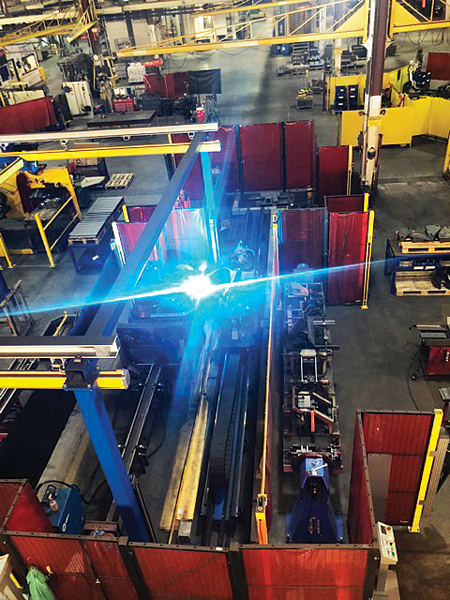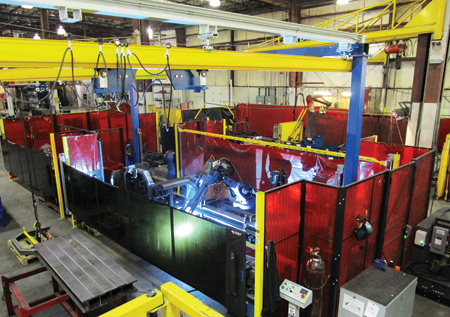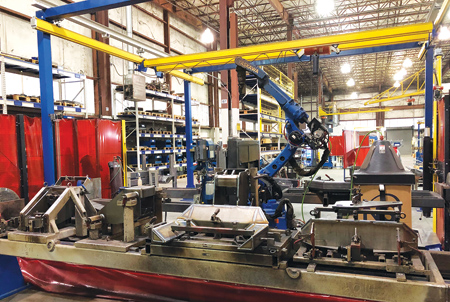
Since the workcell's full implementation, the robotic welding of parts with the new automation system has greatly improved part quality

MAHA USA replaced inefficient robotic technology with a new automation workcell, resulting in reduced scrap and elimination of rework.

MAHA USA upgraded to a new robotic workcell with seam tracking capability, eliminating production bottlenecks and quality issues.
A manufacturer of vehicle lifts for automotive and heavy-duty maintenance operations, MAHA USA unites German engineering with American craftsmanship to produce high-quality workshop equipment. Since the German subsidiary's founding in 1999, MAHA USA, with the support of a large distributer network, has delivered "Made in the USA" products to customers of all sizes in North American and international markets.
The team at the company's state-of-the-art 90,000 sq. ft. manufacturing facility in Pinckard, AL, implements high-quality standards to focus on a well-designed and efficiently built series of mobile column lifts.
A Necessary Upgrade
Dedicated to offering customers high-end products via on-time delivery, MAHA USA decision makers were mindful of the aging arc welding workcell being used to manufacture 5/16 x 3/8 x ?" carbon steel components for the company's main production product line of mobile column lifts. The lack of seam tracking capability on the robot arm was noticeable, impacting the aesthetics of the parts produced. This prompted the operator to frequently carry out visual inspections of the weld joint, and in most cases, costly and timely rework (five to 20 minutes per part) of the weld seam needed to be performed.
As a result, an abundance of scrap was produced, necessitating the employment of two extra workers dedicated to cleanup duties. Likewise, the age of the robot necessitated a demanding maintenance schedule, contributing to robot downtime. The time and energy spent on set-up for part changeover was quite extensive as well, slowing production.
To create better quality welds more efficiently, MAHA USA began the search for an ideal solution to address operation dilemmas. Because of the nature of the application and the use of large fixtures, it was determined that a new robotic workcell-equipped with a servo track and a long-reach robot with high repeatability-was needed. Likewise, seam tracking technology to improve weld quality and to optimize production was a must.
Extended-Reach, Seam Tracking Solution
After completing a thorough search for the best long-reach robot to meet their application demands, MAHA USA partnered with Yaskawa Motoman to implement a four-station robotic welding system to assist with the manufacturing of carbon steel components. The solution featured one Yaskawa Motoman robot; an MA2010 extended-reach welding robot equipped with a Miller Auto-Axcess 450-DI power source and a Binzel ROBO WH505 torch. The robot also featured a ComArc IV seam tracking package with 200-V high-speed touch sensing function to compensate for weld joint location variance, producing precise and clean welds.
Application demands also required the use of four 3,000 kg payload capacity MHT-1655 headstock/tailstock positioners, each equipped with a patented MotoMount fixture mounting system to simplify tooling and reduce stress on positioner bearings. An oversized 10 m servo track with a 7.8 m stroke was also included in the workcell to serve as a carriage for the robot and welding wire.
Fast Results, Big Impact
Since the workcell's full implementation, the robotic welding of parts with the new automation system has greatly improved part quality and worker satisfaction. "Most importantly, the workcell's extended-reach robot, robust welding package, seam tracking capabilities and servo robot carriage work together to produce the high-quality welds desired by customers, achieving corporate goals and meeting worker expectations," said a company spokesperson.
The four-station system operates 20 hours a day, four days a week to maintain a regular production schedule. While the contribution of seam tracking technology adds to the cycle time of each part, the lack of rework-a result of the new seam tracking system-improves the overall cycle time, optimizing productivity.
The new solution utilizes the same manpower investment as before: one person to operate the robot and two others to help manage the workcell and subsequent part transfer. While the latter two workers still perform cleanup duties, the time currently spent on this task is considerably less than before, boosting employee morale and freeing workers to focus on custom orders.
"Overall, MAHA USA has experienced a smooth transition between using the old welding system and implementing the new automation workcell," said the spokesperson. "The prior robot programming knowledge possessed by team members, plus the use of the same weld parameters, greatly contributed to the quick utilization of the workcell. Likewise, the flexibility for changeover provided by the new welding system, combined with the high-speed robot and innovative technologies integrated into the welding system, has delivered transformative results, setting the company up for rapid ROI and future success."
For more information contact:
MAHA USA
2404 East Highway 134
Pinckard, AL 36371
866-624-2872
sales@maha-usa.com
www.maha-usa.com
Yaskawa America, Inc.
Motoman Robotics Division
100 Automation Way
Miamisburg, OH 45342
937-847-6200
www.motoman.com